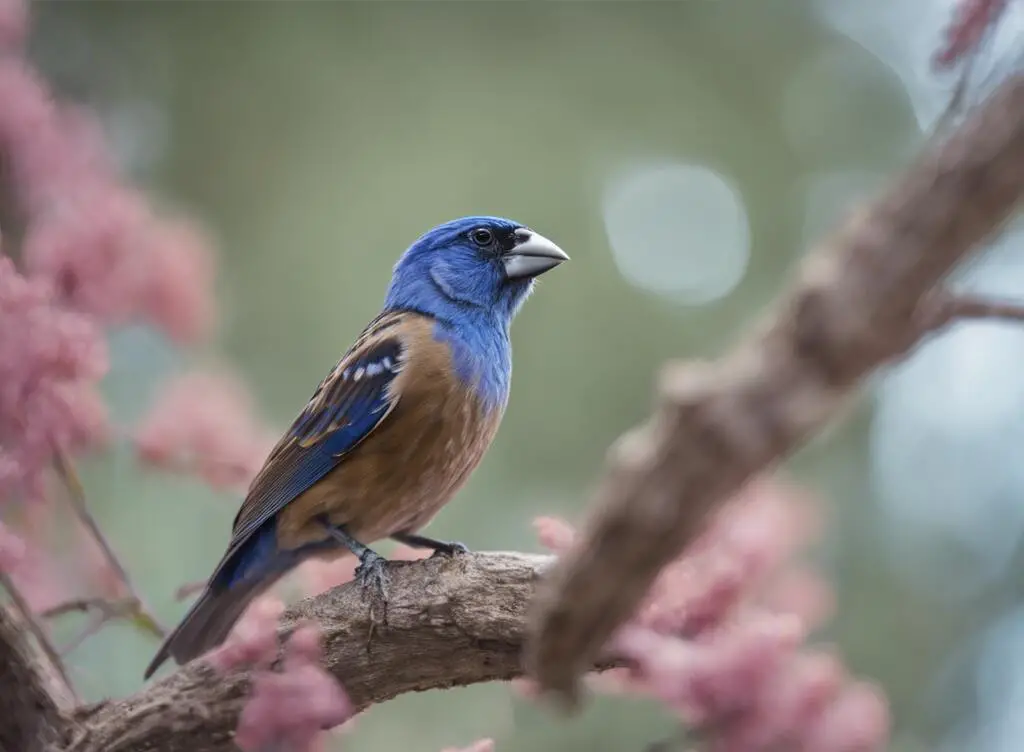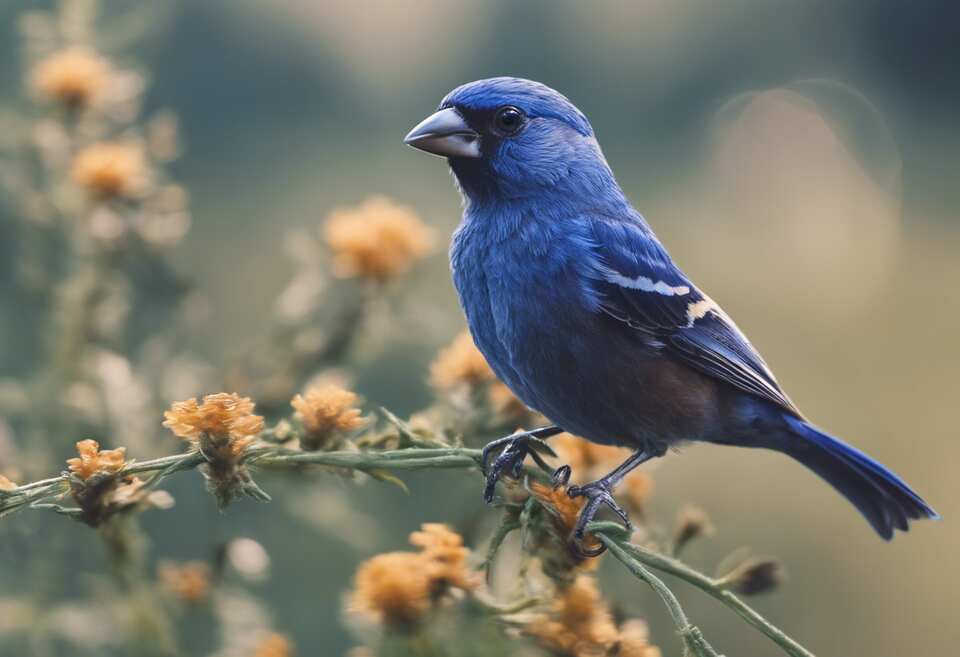The Blue Grosbeak is one of North America’s most notable songbirds. With metallic blue plumage, they are hard to miss. But what are some facts about this bird you may not know?
In this article, we will explore some Blue Grosbeak interesting facts with accompanying photos and identification information.
Table of Contents
- 1 Quick Facts on the Blue Grosbeak
- 2 How to Identify a Blue Grosbeak
- 3 Classification and Taxonomy
- 4 Size and Weight
- 5 Distribution Map and Range
- 6 Calls and Songs
- 7 Lifespan Overview
- 8 Natural Habitat
- 9 Diet and Feeding Habits
- 10 Life Cycle Stages
- 11 Migration Patterns
- 12 Nesting Habits
- 13 Common Behaviors
- 14 Natural Predators
- 15 Not Territorial Nature
- 16 Conservation Status and Efforts
- 17 Author
Quick Facts on the Blue Grosbeak
- The Blue Grosbeak’s feathers are predominantly black with streaks of white, red and purple in them.
- Males usually have brighter colors than females.
- The male sings to attract females, and when a female chooses him as her mate, he will sing louder than before. This makes for an amazing mating call!
- These birds tend to prefer open woodlands, prairies and scrubby areas for their habitat.
- They will also often live near water sources such as ponds or streams.
- Blue grosbeaks have an average lifespan of 6-7 years in the wild.
- The most common call of this species is an insect-like buzzy trill or a scratchy “tseep”.
- Blue Grosbeaks usually breed in colonies with other species such as house finches, blackbirds.
- It feeds on seeds and berries and often migrates to warmer climates during winter months.
- These birds live primarily in deciduous forests where they can find trees to build nests with, fruit-bearing plants for food, and insects as well as small vertebrates to feed on.
- The blue grosbeak was first documented by Lewis in 1806 as “Loxia cyanea”.
- The Blue Grosbeak’s natural habitat is the subtropical or tropical moist lowland forest of Central America, South America, and southern Mexico.
- They are migratory birds and will travel up to 5,000 miles each year to avoid the cold winter months.
- These birds live in areas with dense underbrush because they like to hide their nests from predators.
- Their range includes the United States, Canada, Mexico, Central America, and parts of South America.
- There are seven subspecies of this bird which can be found across Central America to the southern U.S., Mexico and into Canada. The largest populations exist in Texas, Louisiana, Mississippi and Florida where they live in pine forests.
How to Identify a Blue Grosbeak
The blue grosbeak, similar in size to a large finch, is notable for its bright blue plumage, black face, and rusty orange wing bars. The male also features a long tail that can be raised as an alert signal. These birds are classified as large finches, making them one of the larger songbirds in North America.
| Characteristic | Description |
|---|---|
| Size | Similar to a large finch |
| Plumage | Bright blue with black face and rusty orange wing bars |
| Tail | Long tail in males, raised as an alert signal |
| Length | 5.5-6.5 inches |
| Weight | Approximately 1 ounce |
| Classification | Large finch |
| Notable Fact | One of the larger songbirds in North America |
Classification and Taxonomy
- Kingdom: Animalia
- Phylum: Chordata
- Class: Aves
- Order: Passeriformes
- Genus: Passerina
- Family: Cardinalidae
- Species: P. caerulea
- Scientific Name: Passerina caerulea
Size and Weight
- Length: 5.9-6.3 in (15-16 cm)
- Weight: 0.9-1.1 oz (26-31 g)
- Wingspan: 11.0 in (28 cm)
Distribution Map and Range
The Blue Grosbeak is a migratory bird that breeds in Northern Mexico and the Southern United States and winters in Central America. The blue Grosbeak ranges from coastal Texas and Louisiana, to the central parts of Mexico, as well as Belize, Guatemala, Honduras, El Salvador, Nicaragua, Costa Rica and Panama.
Calls and Songs
The blue Grosbeaks are a type of bird that is quite different from the others. They have a rich, musical warble that continuously flows for about 2 to 3 seconds. If you disturb them, they will give out a loud metallic chink call. Additionally, they will also give out low, lively calls.
Listen: Calls and Songs
Lifespan Overview
The lifespan of a blue grosbeak can vary greatly depending on the bird’s environment and luck. In the wild, blue grosbeaks usually live for seven to eight years, but some individuals have lived up to twelve years with good fortune.
These birds are social animals and need plenty of companionship in order to thrive. If they live in captivity, their lifespan is typically much shorter due to their lack of access to a natural environment and other birds.
Natural Habitat
They can be found in all parts of the US, but are most common in Eastern North America. There is no one spot where blue grosbeaks thrive more than any other, but there are certain conditions they like to live in: dry soil, fields of weeds or grasses, woodlands with oak trees, low shrubs near a stream or riverbank.
However, they also need shelter from predators, so they may choose to nest in trees, or brushy areas close to open ground.
Diet and Feeding Habits
The grosbeak lives mostly on seeds of tree-shrubbery, plants, fruits, and nectar. They also eat insects, such as snails, spiders, seeds, grains, and wild fruits, sunflower seeds, millet, oats, buckwheat, and grasses.
Life Cycle Stages
The bird’s breeding life cycle begins in the spring, when the female does its egg laying. It then spends its first year growing and resting before starting its reproductive cycle in summer. The baby birds are called fledglings. After three months, the chicks hatch and the male sings to attract females.
The young birds must remain close to their parents during the winter months in order to grow and mature. They will spend up to one-fourth of their lives in this juvenile stage.
Migration Patterns
The blue grosbeak is a migratory bird that flies from Central America to the U.S. every year. Blue Grosbeaks typically migrate in late September and early October, but their migration periods can be anywhere from August to November, depending on when they breed in Mexico or where they were born before migrating north.
Nesting Habits
Blue grosbeaks nest in the branches of tall trees or shrubs near water sources like rivers and streams. They build their nests from natural materials they find on the ground or up high on plants close by to protect them from predators. They also make use of nesting boxes that are often made available for them.
The female lays four to six eggs and incubates them for 13 days before they hatch. The male feeds her during this time, as well as bringing food back to the nestlings when they start eating after hatching.
Common Behaviors
The male Blue grosbeaks also display their beaks and feet in a variety of ways. One of the best ways to see this is to watch male Blue grosbeaks with their legs outstretched as they fly.
This is done by a bird in the act of courtship, where the male is trying to woo a female. The male will often hold its feet outstretched on the ground and make a series of “puffs” to the female. The female will often follow closely behind it, sometimes stopping to admire the bird’s feet or even peck them.
Another interesting and unique Blue grosbeak display is the bird fluffing its feathers. The female then will stop to inspect the bird’s feet. While feeding, this bird will “stalk” the bird that is eating, moving from one leg of food to another. In some birds, the bird will even flap its wings and fluff its beaks in a way that indicates it wants to eat something.
Male Blue grosbeak are the only birds in which males will attack other males when mating is near. When a male is attacking another male, he is usually not aggressive to the male. The male that is attacked will quickly retreat back to the nest, which makes the fight, over, even more interesting!
Natural Predators
Grosbeaks are a vulnerable bird species that is predated on by several different birds, including raptors. It is also eaten by snakes and cats.
Not Territorial Nature
These birds are not territorial and will not fight with other birds. They are very social birds that spend much of their time in groups, either in pairs or as flocks or flocks of thousands.
Because of the wide geographic distribution of this bird, they have become a popular choice of bird feeders.
Conservation Status and Efforts
The Blue Grosbeak is not endangered, considered a least concern species by the U.S. Fish and Wildlife Service. The bird is common throughout its range and does not require special conservation measures.
Related Post: How To Attract Rose-breasted Grosbeak: The Easiest Way!



